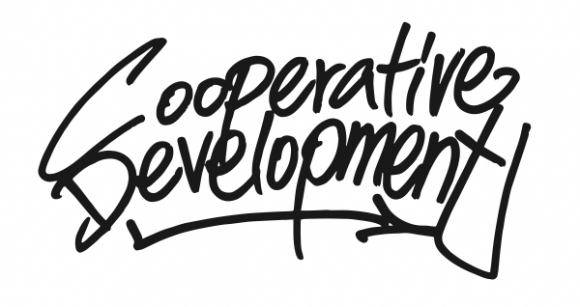
CONTENTS
SUMMARY
$$$
PEOPLE
ADMINISTRATION
SUMMARY
“Development” is a fraught term, as – due to the ubiquitousness of capitalist values - it has come to be associated closely with “growth” and “expansion” in relation to capital. Additionally, it can be used to obfuscate processes like gentrification, in which low income communities are displaced by property and land owners choosing to develop higher “value” properties for wealthier people. By growing the amount of financial investment in a community in a way that makes rent, goods, and services in the area more expensive, this process is lauded as “development,” but at incalculable costs of culture, relationships, history, and broad-spectrum affordability as it essentially changes who can live in a place. “Cooperative Development '' rejects such capitalistic framings in its embrace of development as a constant process and as a striving for holistic betterment that extends well beyond notions of capital growth or property expansion. Developing one’s personality to be more cooperative, or even shrinking the scope of a cooperative’s activities in order to meet the needs of workers for fewer responsibilities are both examples of cooperative development. “Cooperativism is fundamentally an organic process of experiences'' and cooperatives are “an experience of perpetual development” (Arizmendiarrieta, 1999, 114, 112). There are key time periods within a cooperative’s life cycle that are more notable as times of development, those times when transformation is happening with explicit intention and at such a scale that it needs to be supported with additional resources, participation, and/or organization. What resources, how people are recruited to participate in, and the methods and mentality used to manage these key periods of development have great bearing on how cooperative, i.e. how successful, the transformations will be.
$$$
Starting a cooperative and expanding or evolving a cooperative’s activities both typically require an infusion of financial capital or material resources - even if the enterprise does not structure its operations around fiscal transactions. Conventional for-profit and non-profit enterprises have relatively easy access to financial systems (e.g. conventional banks) that regularly support these aspects of an enterprise’s lifecycle. However, as outlined in the key issue section on “Capital,” these systems actively exclude cooperative enterprises or demand compliance with structural and procedural standards that degrade the enterprise’s Cooperative Identity. Coopyouth are doubly excluded from these systems, by virtue of their “lack” of experience, credit history, and/or collateral. As a result, some of the most creative financing strategies have been evolved by coopyouth during periods of cooperative development, by leveraging whatever capital, labor, or relationships they already possess collectively as a group.
PEOPLE
Developing a cooperative is often framed as an unconventional type of conventional business development; however, business development literature and practices typically focus entirely on organizational structure, financial portfolio, market research, and other aspects of an enterprise that have little or nothing to do with the specific people involved. In fact, many business development frameworks take on more of an “if you build it, they will come” mentality in designing an organizational structure that they then fill with people. With cooperative development, the main task is organizing people according to their needs and abilities. “First people, then cooperatives” (Arizmendiarrieta, 1999, 14). There are cooperative development methods that also employ an “if you build it, they will come,” in which a professional developer will “incubate” a cooperative enterprise then slowly relinquish control of to a group of members. As discussed at various points in relation to elders creating programs and organizations for youth, these transition processes are incredibly challenging, as its inherent paternalism has the potential to be fatally disempowering to the cooperative’s eventual membership, and the process then sometimes results in a cooperative being constantly overseen by the professional developer to ensure it does not “fail.” How cohesive a membership is anecdotally has more bearing on the success of the cooperative endeavor than what product or service they offer or their provision and distribution strategies. In a strong cooperative group, if one strategy doesn’t pan out, sufficient relationships and trust have been built that the group can pivot to a new idea if they so choose. Cooperative development focuses on the development of individuals and their relationships with one other, first and foremost.
ADMINISTRATIVE
Often, during phases of intentional development in a cooperative, there is a great deal of logistical and administrative work that has to be coordinated. Of that work, the bureaucracy that many cooperatives have to navigate if they are compelled or choose to interact with a regulatory (e.g. municipality for a permit) or financial (e.g. moneylender) institution is especially notable. The external pressures on the internal development process are hard to estimate effectively, given the lack of control the cooperative has over those processes. Pages of paperwork, hours spent on customer service calls, and reading through highly technical documentation just to figure out what paperwork needs to be completed and which phone number needs to be called can be enough to sink a blossoming cooperative endeavor. “The cooperative mystique is like quiksilver; put an official finger upon it, and it slips away” (Laidlaw, 1980, 40). Additionally, sometimes the institutions will try to put a stop to the project by declaring it illegal, requiring the cooperative to apply for so many permits that the filing fees become prohibitive, or simply putting up roadblocks that can only be avoided with institutional influence, personal relationships with power holders, or an unreasonable amount of patience and persistence. Most of the administrative challenges within cooperative development processes are external, and can be attributed to bureaucracy, incompetence, corruption, or a mix thereof. However, some processes don’t require any participation with outside systems, making them much simpler.
